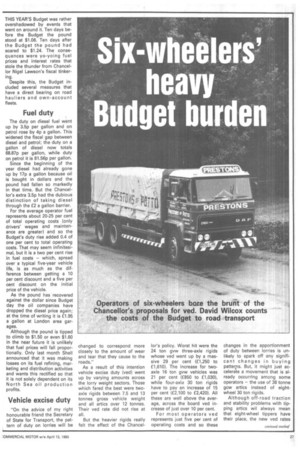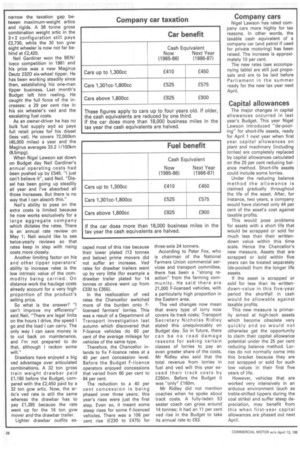THIS YEAR'S Budget was rather overshadowed by events that went
Page 29

Page 30

If you've noticed an error in this article please click here to report it so we can fix it.
on around it. Ten days before the Budget the pound stood at $1.06. Ten days after the Budget the pound had soared to $1.24. The consequences were yo-yoing fuel prices and interest rates that stole the thunder from Chancellor Nigel Lawson's fiscal tinkering.
Despite this, the Budget included several measures that have a direct bearing on road hauliers and own-account fleets.
Fuel duty
The duty on diesel fuel went up by 3.5p per gallon and on petrol rose by 4p a gallon. This widened the fiscal gap between diesel and petrol; the duty on a gallon of diesel now totals 68.87p per gallon, while duty on petrol it is 81.56p per gallon.
Since the beginning of the year diesel had already gone up by 17p a gallon because oil is bought in dollars and the pound had fallen so markedly in that time. But the Chancellor's extra 3.5p had the dubious distinction of taking diesel through the £2 a gallon barrier.
For the average operator fuel represents about 20-25 per cent of total operating costs (only drivers' wages and maintenance are greater) and so the Budget's duty rise added 0.4 of one per cent to total operating costs. That may seem infinitesimal, but it is a two per cent rise in fuel costs — which, spread over a typical five-year vehicle life, is as much as the difference between getting a 10 per cent discount and a five per cent discount on the initial price of the vehicle.
As the pound has recovered against the dollar since Budget day the oil companies have dropped the diesel price again; at the time of writing it is £1.95 a gallon at London area garages.
Although the pound is tipped to climb to $1.50 or even $1.60 in the near future it is unlikely that fuel prices will fall proportionally. Only lest month Shell announced that it was making losses on its fuel refining, marketing and distribution activities and wants this rectified so that it is not solely dependent on its North Sea oil production profits.
Vehicle excise duty
"On the advice of my right honourable friend the Secretary of State for Transport, the pattern of duty on lorries will be changed to correspond more closely to the amount of wear and tear that they cause to the roads."
As a result of this intention vehicle excise duty (ved) went up by varying amounts across the lorry weight sectors. Those which fared the best were twoaxle rigids between 7.5 and 13 tonnes gross vehicle weight and all artics over 12 tonnes. Their ved rate did not rise at all.
But the heavier rigids really felt the effect of the Chancel lor's policy. Worst hit were the 24 ton gvw three-axle rigids whose ved went up by a massive 29 per cent (£1,250 to £1,610). The increase for twoaxle 16 ton gvw vehicles was 21 per cent (£850 to £1,030), while four-axle 30 ton rigids have to pay an increase of 15 per cent (£2,100 to £2,420). All these are well above the average, across the board ved increase of just over 10 per cent.
For most operators ved represents just five per cent of operating costs and so these changes in the apportionment of duty between lorries is unlikely to spark off any significant changes in buying pattecns. But, it might just accelerate a movement that is already occurring among some operators — the use of 38 tonne gcw artics instead of eightwheel 30 ton rigids.
Although off-road traction and stability problems with tipping artics wil always mean that eight-wheel tippers have their place, the new ved rates narrow the taxation gap between maximum-weight artics and rigids. A 38 tonne gross combination weight artic in the 3+2 configuration still pays £2,730, while the 30 ton gvw eight wheeler'is now not far behind at £2,420.
Neil Gardiner won the BEN/ Iveco competition in 1981 and his prize was a new Magirus Deutz 232D six-wheel tipper. He has been working steadily since then, establishing his one-man tipper business. Last month's Budget left him reeling. He caught the full force of the increases: a 29 per cent rise in his six wheeler's ved and the escalating fuel costs.
As an owner-driver he has no bulk fuel supply acid so pays full retail prices for his diesel (less vat). He covers 72,000km (45,000 miles) a year and the Magirus averages 33.2 I /100km (8.5mpg).
When Nigel Lawson sat down on Budget day Neil Gardiner's annual operating costs had been pushed up by £545. "I just can't believe it", said Neil. "Diesel has been going up steadily all year and I've absorbed all those increases. But there is no way that I can absorb this."
Neil's ability to pass on the extra costs is limited because he now works exclusively for a large aggregate company which dictates the rates. There is an annual rate review on May 1; Neil would like to see twice-yearly reviews so that rates keep in step with rising costs more closely.
Another limiting factor on his and other tipper operators' ability to increase rates is the low intrinsic value of the commodity being carried. On distance work the haulage costs already account for a very high proportion of the product's selling price.
So what is the answer? "I can't improve my efficiency" said Neil. "There are legal linits on the hours I drive, the speed I go and the load I can carry. The only way I can save money is to cut back on maintenance, and I'm not prepared to do that, although I reckon some will."
Drawbars have enjoyed a big ved advantage over articulated combinations. A 32 ton gross train weight drawbar paid £1,180 before the Budget, compared with the £2,450 paid by a 32 ton gcw artic. Now, the artic's ved rate is still the same whereas the drawbar has to pay £1,385 because the rate went up for the 16 ton gvw mover and the drawbar trailer.
Lighter drawbar outfits es caped most of this rise because their lower plated (13 tonnes and below) prime movers did not suffer an increase. Ved rates for drawbar trailers went up by very little (for example a drawbar trailer plated for 14 tonnes or above went up from £330 to £355).
In the reallocation of ved rates the Chancellor switched more of the burden onto Flicensed farmers' lorries. This was a result of a Department of Transport investigation last autumn which discovered that F-licence vehicles do 60 per cent of the average mileage for vehicles of the same type.
Therefore, the Chancellor intends to fix F-licence rates at a 40 per cent concession level. Before the Budget F-licence operators enjoyed concessions that varied from 60 per cent to 84 per cent.
The reduction to a 40 per cent concession is being phased over three years; this year's rises were just the first step. Even so, it meant some steep rises for some F-licenced vehicles. There was a 106 per cent rise (£230 to £475) for three-axle 24 tanners.
According to Peter Fox, who is chairman of the National Farmers Union commercial services and transport committee, there has been a "strong reaction" from the farming community. He said there are 21,000 F-licensed vehicles, with a particularly high proportion in the Eastern area.
The ved changes now mean that every type of lorry now covers its track costs; Transport Secretary Nicholas Ridley stated this unequivocably on Budget day. So in future, there can be no road damage reasons for asking certain classes of lorries to pay an even greater share of the costs. Mr Ridley also said that the total revenue from lorries in fuel and ved will this year exceed their track costs by £260m. Before the Budget it was "only" £160m.
Mr Ridley did not mention coaches when he spoke about track costs. A fully-laden 53 seater coach can gross around 14 tonnes; it had an 11 per cent ved rise in the Budget to take its annual rate to £83.
Company cars
Nigel Lawson has rated company cars more highly for tax reasons. In other words, the taxable cash equivalent of a company car (and petrol if used for private motoring) has been raised. The increase is approximately 10 per cent.
The new rates (see accompanying table) are still just proposals and are to be laid before Parliament in the summer ready for the new tax year next April.
Capital allowances
The major changes in capital allowances occurred in last year's Budget. This year Nigel Lawson introduced "de-pooling" for short-life assets, ready for April 1 next year when first year capital allowances on plant and machinery (including lorries) are completely replaced by capital allowances calculated on the 25 per cent reducing balance method. Short-life assets could include some lorries.
Under the reducing balance method the allowance is claimed gradually throughout the life of the asset. After, for instance, two years, a company would have claimed only 44 per cent of the asset's cost against taxable profits.
This would pose problems for assets with a short life that would be scrapped or sold for much less than their writtendown value within this time scale. Hence the Chancellor's new measure. Assets that are scrapped or sold within five years can be treated separately (de-pooled) from the longer life assets.
If the asset is scrapped or sold for less than its writtendown-value in this five-year period the shortfall in cash would be allowable against taxable profits.
This new measure is primarily aimed at high-tech assets which become obsolete very quickly and so would not otherwise get the opportunity to claim their capital allowance potential under the 25 per cent reducing balance method. Lorries do not normally come into this bracket because they are not scrapped or sold for such low values in their first five years of life.
However, vehicles that are worked very intensively in an arduous environment (such as treble-shifted tippers during the coal strike) and suffer steep depreciation, may benefit from this when first-year capital allowances are phased out next April.




















































































